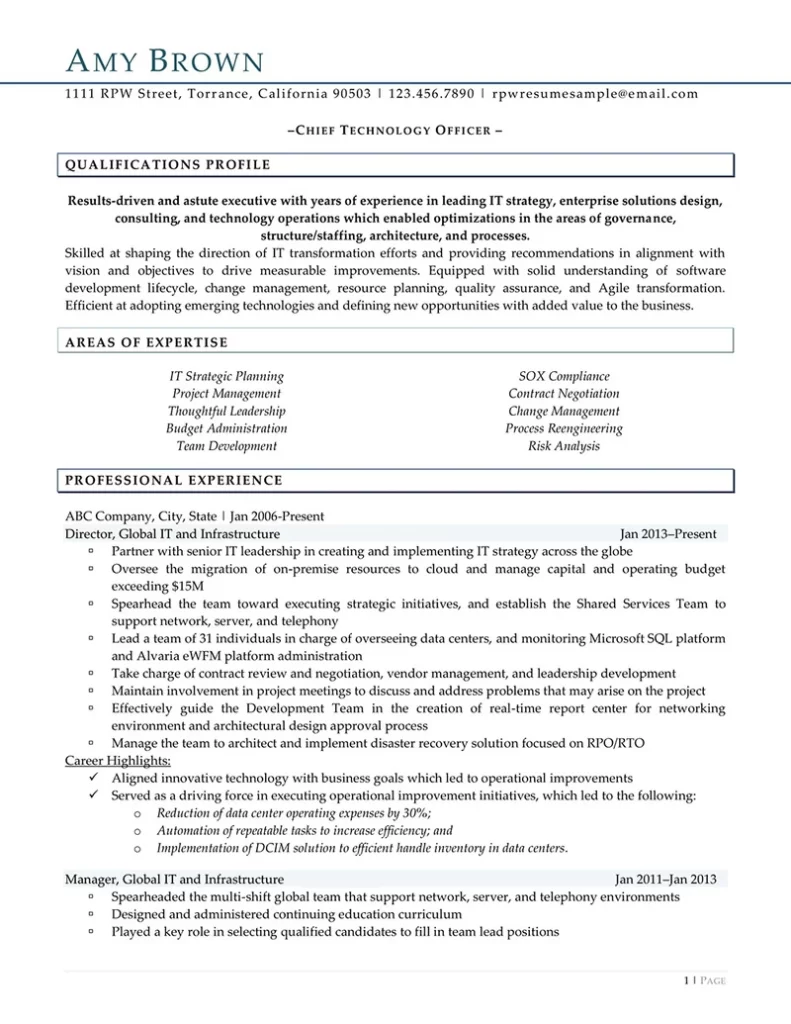Industries rely heavily on technology. From the dawn of the industrial revolution to the present day, technology has been the driving force behind the entire labor system. In the case of corporations, in addition to the chief executive, financial, and information officers, a chief technology officer (CTO) is needed to achieve technological developments. This is why this content would touch upon a job-winning CTO resume amid today’s very competitive job market.
Nowadays, in order to achieve the developments that come with it, organizations need professionals who will lead and manage their business. Likewise, a CTO post is vital because it serves as a catalyst for developing and improving the company’s technical operations and products. It is undeniable that the demand for this executive position is fierce. Even the US Bureau of Labor Statistics reported that the employment of top executives is expected to grow 8% between 2020 and 2030, while that of computer and information systems managers is projected to grow 11% during the same time period.
Each year, there are approximately 42,400 to 247,100 projected openings for these leadership positions. If you want to be a CTO, you must meet or even exceed the requirements for the position. To get started on this senior management journey, you must have a job-winning resume that highlights your most impressive accomplishments. Read on to learn what details you should include on your CTO resume, along with effective tips in writing one.
What is a Chief Technology Officer?
The CTO is the key executive in charge of an organization’s technological needs, opportunities, and challenges. This executive serves as the lead technology officer for a company. Thus, CTOs stay on top of technological trends and align their strategies with the overall goal of the company.
In addition, CTOs take charge of managing technology deployment, technology budgets, client relations, and investment decisions. CTOs report directly to the CEOs and serve as technology and business experts. They also partner with CIOs in making decisions that will influence the company’s current and future operations.
What are the Duties of a Chief Technology Officer?
As a CTO, you must be 10 steps ahead of your team in terms of technological knowledge. You must be well informed about rapidly changing technology and how it can best suit and fit your company. That said, to give you an idea of what a CTO’s day-to-day entails, we jotted down the key duties you’d have to execute:
- Monitor and evaluate information technology budgets.
- Manage the research and development (R&D) and technological needs of the organization.
- Determine the company’s opportunities and risks.
- Evaluate technology trends and use it to introduce or improve products and services for the firm’s clients and customers.
- Take part in corporate governance decisions made by management.
- Keep up to date on technological standards and compliance regulations.
- Implement new data security and quality assurance procedures.
- Inform management, partners, investors, and employees about the company’s technology strategy.
- Assist with the company’s recruitment, retention, acquisition, and sales efforts.

How Do You Become a Chief Technology Officer?
In order to become a CTO, you should have a bachelor’s and master’s degree in information technology or a related computer science field. It is preferable to have a second degree, such as an MBA. You must have at least five years of managing experience in addition to the educational background that will serve as the foundation for the CTO rule.
Moreover, to be considered for this executive job, you must have years of experience in a leadership role. CTOs must also have advanced software talents, exceptional problem-solving skills, remarkable team management abilities, strong communication abilities, and a visionary and strategic mindset.
While there are no CTO-specific certificates, anyone pursuing a CTO position should also obtain certifications in project management, development, programming, or database administration.
What to Include in Your CTO Resume
In addition to the qualifications needed to become a CTO, you will need a powerful CTO resume to express your interest in the position. Therefore, knowing the resume outline or important parts to include on your CTO resume is critical in order to capture the attention of hiring managers or board of directors, and even get past the applicant tracking system (ATS). Here, we’ve compiled a list of the most important things you should include in your resume:
Updated Contact Information
Begin with your first and last name, complete mailing address with ZIP code, active contact number, and personal email address in your CTO resume heading. It’s also a good idea to include the URL of your LinkedIn profile or personal website, if you have one. Additionally, listing your certifications or licenses next to your name can help you get a favorable response from hiring managers.
Specific Target Job
It’s also referred to as a “career tag” by professional resume writers and career coaches because it informs hiring managers and recruiters about the type of work you’re looking for.
Qualifications Profile / Executive Profile
This section, also known as the resume summary, can make or break your job application. This enables you to highlight the combination of your qualifications, skills, expertise, experience, and best accomplishments in a brief and concise manner that will impress hiring managers. That being said, take advantage of this opportunity to demonstrate what you can bring to the table and how you can help their organization.
Expert Tip:
Rather than writing a resume objective-type statement, create eye-catching resume titles and headlines to keep hiring managers reading your CTO resume.
Areas of Expertise or the Skills Section
This section gives you the opportunity to highlight your abilities, knowledge, and experience. You can show hiring managers what you can bring to their company and whether you have the necessary skills.
Related Article:
Professional Experience
While you may have a long list of impressive achievements, include only those that are relevant to the firm and job you are applying for, as well as those that demonstrate your management abilities. A new task responsibility and how to apply it is a useful accomplishment to highlight on a CTO resume. While writing about your accomplishments, use numbers to give hiring managers a solid idea of the impact you had.
Education
Your academic background is also beneficial to your job search. Candidates with completed degrees are preferred by most employers, particularly if they are relevant to the job position.
Your resume’s education section should be well-organized. From the most recent years of completion to the oldest, write in reverse chronological order. List any relevant degrees you’ve earned from the universities you’ve attended. Mention any academic awards or other noteworthy achievements and honors.
Licenses, Certifications, and Training
In the certifications section, include any diplomas, qualifications, or internships that are relevant to your leadership development. Professional memberships offer similar chances to broaden and improve your knowledge and skills. Don’t overlook anything that establishes you as someone who values lifelong learning in order to stay current in your field and on top of their game.

How to Write Your CTO Resume
Apart from knowing what to include on your job application tool, you should also know how to write your own CTO resume. Consider the following tips when presenting them in your document. Read on.
1. Use a simple yet attractive design and layout.
A visually appealing CTO resume may boost your interview chances. Any appearance that isn’t polished and professional may deter readers from spending more time than their quick glance allows. Make an effort to create a design that is both simple and engaging. Everything should be neat, clean, and well-organized. Make sure there aren’t any distracting patterns, borders, or fonts on your resume.
Related Article:
2. Select the best resume format.
Your resume will be divided into sections based on your work experience, credentials, and skills. If you have years of experience, the chronological style is the best option. Focus on demonstrable advantages to previous employers that you can provide again when deciding which talents and accomplishments to include or exclude.
Related Article:
3. Emphasize your leadership skills.
Leadership is a qualification that qualifies you as a member of an effective management team that helps to improve work efficiency and achieve corporate goals. Leadership skills are necessary regardless of the position you’re applying for or the size of the company. When it comes to demonstrating leadership skills on a resume, you must provide concrete examples that are supported by experiences.
Related Article:
4. Include resume keywords.
Keywords are critical in getting your resume noticed by employers. By including keywords in your resume and cover letter, you can increase your chances of getting a job interview. Keywords are words or short phrases associated with specific job requirements for the applicant tracking system. A hiring manager examines an applicant’s skills, abilities, qualifications, and characteristics. The more similar you are to a match, the more likely you will be screened for an interview.
5. Show off your accomplishments backed by data.
A competent leader’s qualities go beyond the ability to motivate and lead others to achieve work efficiency and precise, measurable results. When writing about previous positions, always use statistics and real facts to quantify your outcomes.
6. Proofread and edit your CTO resume.
Before you submit your CTO resume, go over it several times. This enables you to spot, identify, and correct errors. Remember that your summary section should reflect both your personality and your professional approach. As a leader, you must demonstrate dependability and wit.
Expert Tip:
After you’ve proofread your document, you can use a free online resume review to see if it has what it takes to impress hiring managers.
Chief Technology Officer or CTO Resume Example
A CTO resume sample created by one of our expert resume writers is provided below. Examine how an interview-generating resume is put together to help you create your own.

Related Article:
Your Ultimate Guide in Writing a Topnotch Executive Resume for 2022
Have Professionals Write Your CTO Resume to Secure a Successful Job Search
Organizations rely on top executives to make decisions and establish long-term prospects for success in the marketplace. A CTO is as crucial as other executive responsibilities. If this is the career route you wish to take, your job search tool, such as your CV, should reflect that goal by being outstanding.
Follow our tips on how to write and what to include on your CTO resume. But, if you’re still having trouble writing your own or you lack the time to do so, worry not! You can always trust Resume Professional Writers to write your resume. Hire our best resume writing service today to ace your job hunt and obtain your target CTO post!





